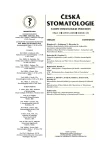-
Články
Top novinky
Reklama- Vzdělávání
- Časopisy
Top články
Nové číslo
- Témata
Top novinky
Reklama- Kongresy
- Videa
- Podcasty
Nové podcasty
Reklama- Kariéra
Doporučené pozice
Reklama- Praxe
Top novinky
ReklamaStabilita okraje kostního lůžka zatěžovaného implantátu – porovnání s matematickými modely
Stability of Bone Bed Crest of Loaded Implant – Comparison with Finite Element Models
The adaptation of the implant bone bed to chewing force has been quite often represented in X-ray images as the bowl shaped resorption around the implant neck. During the first year after the implant loading the marginal bone loss around the neck is more pronounced. Subsequeutly, the rate of the bone loss is either arrested or the resorption of the bone crest continues and the implant is lost within a few years. This study compared stability of the bone bed crest of the loaded implant to the size, shape and inclination of enosseal part of the implant and to the anchored denture. All the implants monitored in the study were scanned by X-ray images every 6 months. The bone profile and stability characteristics for each implant were assembled. Numbers of stable and non-stable implants with respect to their size, shape and inclination of the enosseal part of the implant and to anchored denture were statistically evaluated and compared to mathematical finite element models. Differences among various types of loading, represented by different types of dentures were not significant, excluding a group of fixed bridges, where an implant was used as interpositioned pillar between natural teeth. Correlation between findings in vivo and mathematical models is not distinct. This is probably because movements of mandible and chewing forces are individual and they have not been studied thoroughly yet. Moreover, in models ordinary values were used, whereas in clinical practice it is necessary to use individual values.
Key words:
dental implants – size, shape and inclincation of enosseal part – radiovisiography – dentures – stress distribution – finite element method
Autoři: L. Himmlová 1; T. Goldmann 2; A. Kácovský 2
Působiště autorů: Výzkumný ústav stomatologický 1. LF UK a VFN, Praha přednostka prof. MUDr. J. Dušková, DrSc. 1; ČVUT Praha, Fakulta strojní, Ústav mechaniky, Praha vedoucí ústavu prof. Ing. S. Konvičková, CSc. 2
Vyšlo v časopise: Česká stomatologie / Praktické zubní lékařství, ročník 105, 2005, 3, s. 66-72
Souhrn
Adaptace kostního lůžka implantátu na působící zatížení se v RTG obrazu většinou projevuje jako miskovitá resorpce kosti v okolí krčku implantátu. V prvním roce po zatížení dochází k výraznějšímu úbytku okraje kosti, poté se stav buď stabilizuje nebo resorpce okraje kosti pokračuje až dojde ke ztrátě implantátu. Studie je zaměřena na porovnávání stability okraje kostního lůžka implantátů v závislosti na tvaru, velikosti a sklonu nitrokostní části implantátu a na druhu nesené protetické práce. U sledovaných implantátů byly každých šest měsíců zhotoveny RVG snímky. Z nich byl sestaven profil implantátu a určena jeho stabilita. Počty stabilních a nestabilních implantátů vzhledem k velikosti, tvaru a sklonu nitrokostní části implantátu i k nesené protetické práci byly statisticky zpracovány a porovnány s matematickými modely. Rozdíly mezi jednotlivými způsoby zatížení nejsou signifikantní, s výjimkou implantátu použitého jako vmezeřený pilíř mezi vlastní zuby pacienta. Korelace s matematickými modely není výrazná zejména proto, že pohyby a síly působící při funkci nejsou přesně známé a popsané, a do modelů byly zadány průměrné hodnoty. Pro potřeby klinické praxe je nezbytné matematické modely individualizovat.
Klíčová slova:
dentální implantáty – velikost – tvar – sklon – RVG – protetické práce – matematické modely – metoda konečných prvků
Štítky
Chirurgie maxilofaciální Ortodoncie Stomatologie
Článek vyšel v časopiseČeská stomatologie / Praktické zubní lékařství
Nejčtenější tento týden
2005 Číslo 3- Horní limit denní dávky vitaminu D: Jaké množství je ještě bezpečné?
- Orální lichen planus v kostce: Jak v praxi na toto multifaktoriální onemocnění s různorodými symptomy?
- Diagnostika alergie na bílkoviny kravského mléka − aktuální postupy a jejich vypovídací hodnota
- Benzydamin v léčbě zánětů v dutině ústní
- Efektivita kartáčku Sonicare For Kids u dětí předškolního věku
-
Všechny články tohoto čísla
- Adhezivní systémy v morfologickém obrazu I. Tetric Ceram HB
- Ověření validity měření zubního kazu laserovým fluorescenčním přístrojem KaVo DIAGNOdent
- Prevalence chronické periodontitidy a frekvence zubů s kořenovou výplní v dospělé české populaci
- Dentální fokální infekce
- Stabilita okraje kostního lůžka zatěžovaného implantátu – porovnání s matematickými modely
- Okamžité implantáty a jejich využití v klinické stomatologické praxi
- LCH – histiocytóza z Langerhansových buněk v kraniofaciální oblasti
- Rekonstrukce kostních defektů po operacích objemných čelistních cyst
- Poruchy hojení ran v dentoalveorální chirurgii
- Česká stomatologie / Praktické zubní lékařství
- Archiv čísel
- Aktuální číslo
- Informace o časopisu
Nejčtenější v tomto čísle- Dentální fokální infekce
- Prevalence chronické periodontitidy a frekvence zubů s kořenovou výplní v dospělé české populaci
- Okamžité implantáty a jejich využití v klinické stomatologické praxi
- Ověření validity měření zubního kazu laserovým fluorescenčním přístrojem KaVo DIAGNOdent
Kurzy
Zvyšte si kvalifikaci online z pohodlí domova
Autoři: prof. MUDr. Vladimír Palička, CSc., Dr.h.c., doc. MUDr. Václav Vyskočil, Ph.D., MUDr. Petr Kasalický, CSc., MUDr. Jan Rosa, Ing. Pavel Havlík, Ing. Jan Adam, Hana Hejnová, DiS., Jana Křenková
Autoři: MUDr. Irena Krčmová, CSc.
Autoři: MDDr. Eleonóra Ivančová, PhD., MHA
Autoři: prof. MUDr. Eva Kubala Havrdová, DrSc.
Všechny kurzyPřihlášení#ADS_BOTTOM_SCRIPTS#Zapomenuté hesloZadejte e-mailovou adresu, se kterou jste vytvářel(a) účet, budou Vám na ni zaslány informace k nastavení nového hesla.
- Vzdělávání


